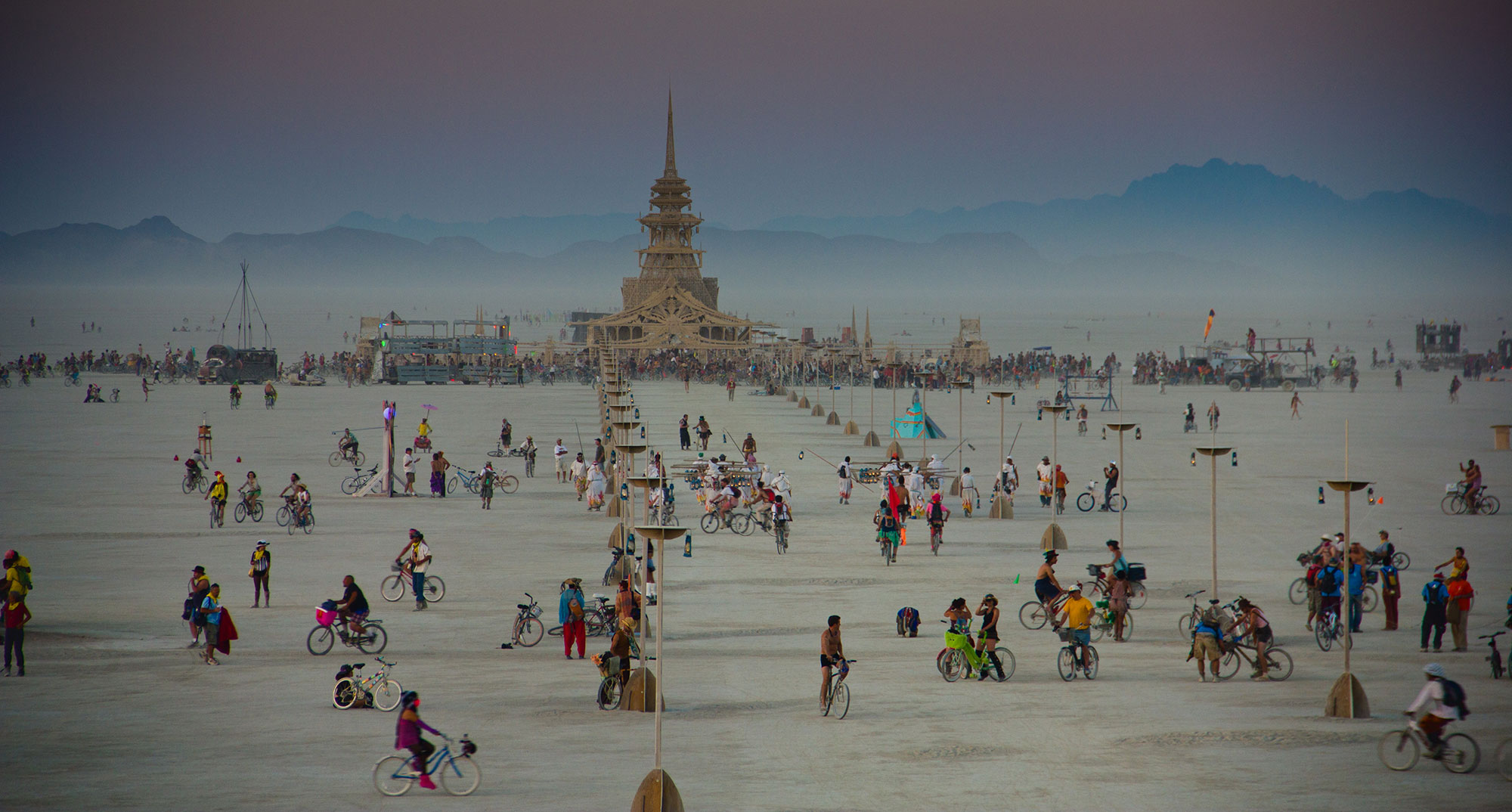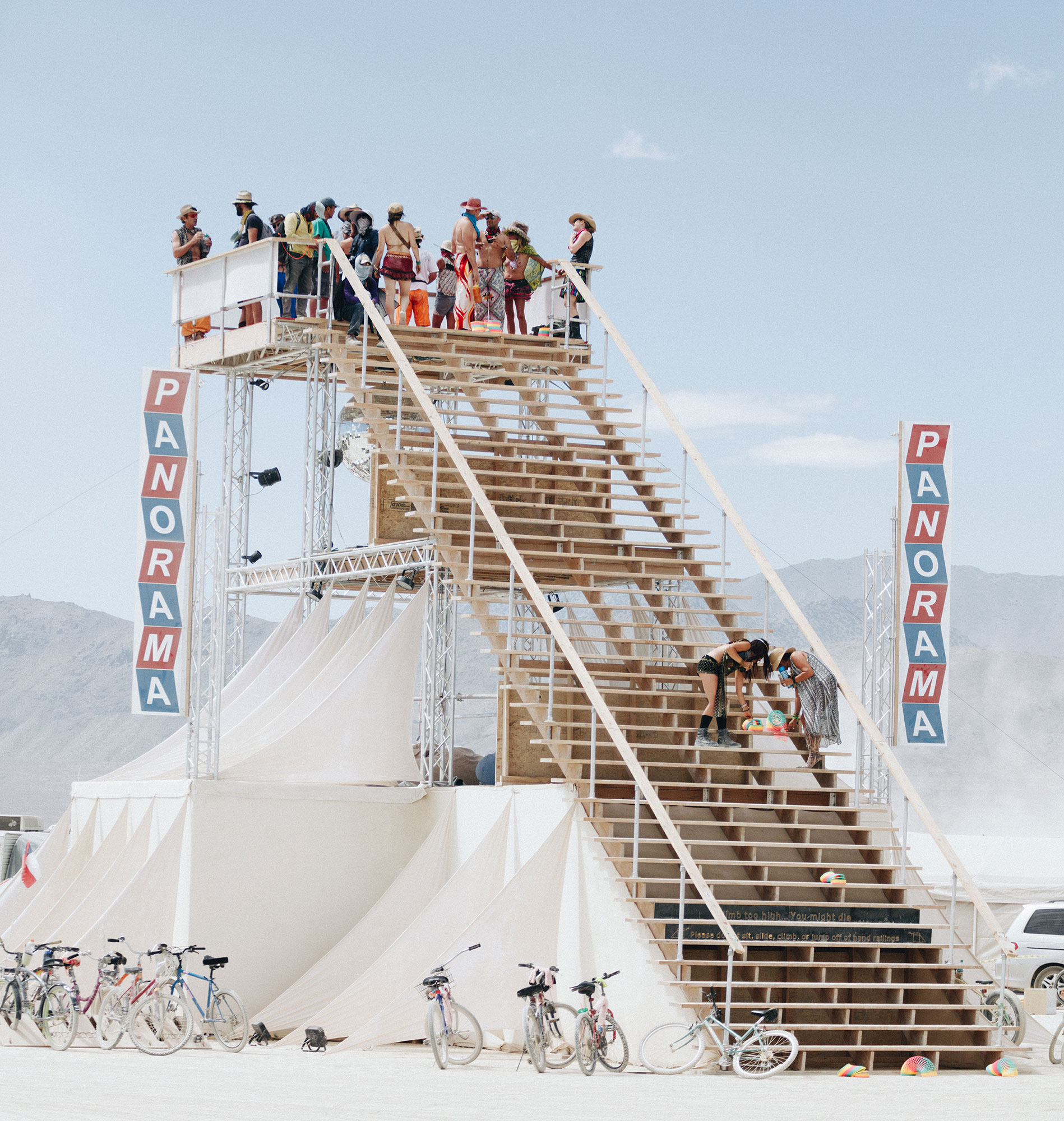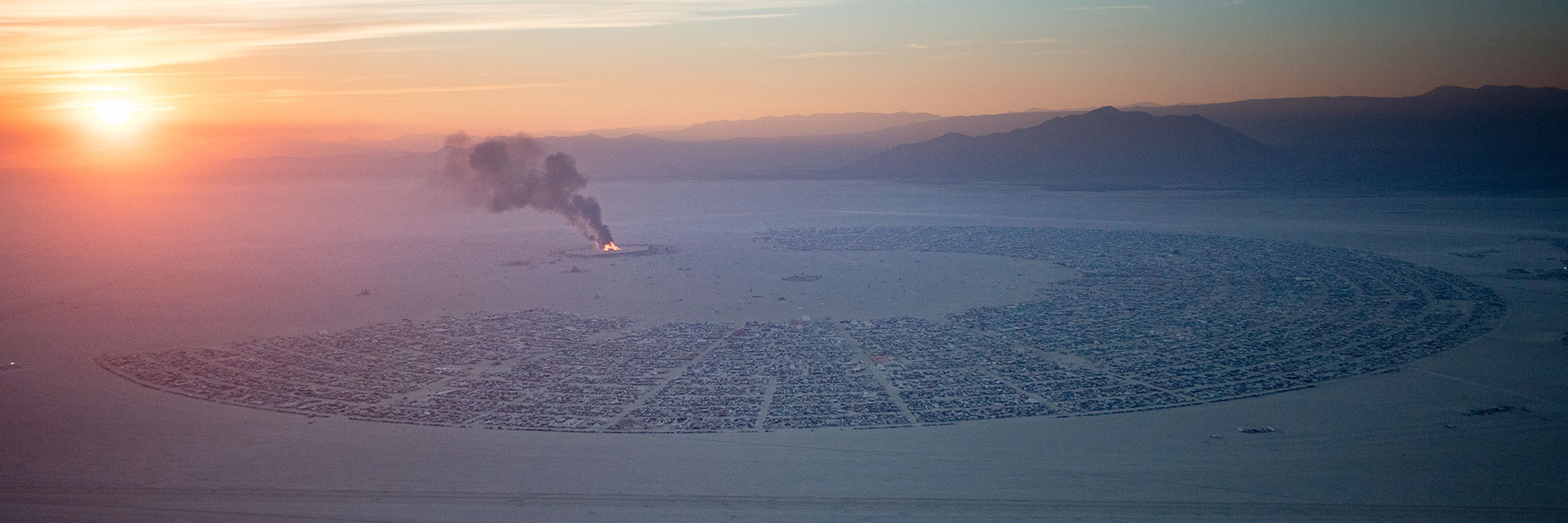There’s a city in my mind

The alkali flats of north-western Nevada’s Black Rock Desert are sparse and unforgiving. Flat and featureless yellow-packed playa (desert basin floor) stretches into the horizon under a 38-degree sun. Once an inland sea, the desert lava beds are the perfect place for faking a moon landing. Low humidity peels back the cuticles and cracks the skin. Swirling particles signal the dust storms that will block the throat and scratch the lenses of the eye, taking visibility down to less than a metre in front of the face. The site of experimental vehicle land-speed records and rocket launches, Black Rock seems an unlikely place for the annual convergence of almost 70,000 people for a festival with no programmed events, no line and nothing for sale. Yet every August, Burning Man brings a temporary self-governing city to the desert.

Burning Man has transformed from a small community festival into a ‘must-do’ on the global event tourism circuit in the space of thirty years. The annual festival now draws a mix of partygoers, experimentalists, activists, committed ‘Burners’, and experience-seekers looking to tick ‘the Burn’ off their bucket list. The ten days of self-curated art, community and self-expression in the desert is also big business. In 2015, according to the After Burn Report now released after each festival, attendees spent an average of AU$2600 during the festival. Twenty per cent of punters came from outside the United States, bringing with them the coveted international tourism dollar.
The success and point of difference from other festivals worldwide is the temporary suspension of patrons in a mental and physical space outside of their everyday reality. This requires a different type of governance that permits all sorts of activities. A not-for-profit based out of California, Burning Man runs primarily on volunteer power. Creating a universal culture of permission and managing a population the size of Greater Bunbury while complying with policy and regulatory conditions is no mean feat. Legal teams negotiate everything from Special Recreation Permits with the federal Bureau of Land Management (BLM) to facilitating thousands of Temporary Food Establishment permits with the Nevada State Health Division that allow festival goers to gift food between each other.

Comforts are few in the harsh Nevada desert, and sustaining Black Rock City is challenging. The temporary autonomous zone is built and maintained through self-regulating urban planning, community services, project grants, public infrastructure, emergency protocols and safety plans. The Black Rock City Department of Public Works (BRC DPW) oversees wayfinding and street surveying. The Department of Mutant Vehicles (DMV) oversees the art cars – pirate ships, dust-bowl era shacks and flamethrowing octopi – that glide past pedestrians and cyclists.
The festival is in many ways an innovation lab for rethinking cities. Infrastructure and services are provided, creating a scaffold for Black Rock City civic engagement as citizens co-create, maintain and dismantle a city in the space of two weeks. Volunteer-provisioned tools are in place to help local communities bring to life various cultural and social enterprise programs in line with the festival’s 10 Principles. The 10 Principles, enshrined by festival founder and Burner guru Larry Harvey, wouldn’t be out of place on the wall of any civic urbanism devotee – radical inclusion, gifting, decommodification, radical self-reliance, radical self-expression, communal effort, civic responsibility, participation, immediacy and leaving no trace.

Black Rock City’s remote location means the majority of festival goers drive, often cross country, while around a third fly. Power-hungry generators scatter the playa and mutant vehicles leave diesel fumes in their wake. The cost and impact of ten days worth of living is apparent after each festival. Burning Man has recognised this impact and has voiced a commitment to reducing the festival footprint. The ‘leave no trace’ principle incorporates MOOPing, or removing all Matter Out Of Place. MOOP includes anything not found on arrival, including grey water, dust dunes and plant matter. Magnet sweepers, rakes and rebar-removing grips are all part of MOOP kits.
The culture cultivated at Burning Man has spread though affiliated regional events. In April 2017 Western Australia hosted for the fourth time its own Burning Man offshoot event, Blazing Swan, at Jilakin Rock City, joining the eastern seaboard’s Burning Seed. Burning Man’s increasing popularity also delivers increasing returns. The organisers estimate the economic impact to Nevada is around $45 million annually. Reno-Tahoe International Airport estimates a $10 million annual contribution as Burners flow through to Reno, stocking up on supplies and stopping for a well-earned shower.

While appraising the bottom line of major events can be fraught, there is no doubt the festival has brought Nevada valuable exposure alongside an influx of new spending. Nearby Reno has leveraged Burning Man’s civic, cultural and innovation ethos to recast itself as a livable, progressive city with a burgeoning start-up and maker scene. The festival has also become an important partner for Gerlach, the 200-person community closest to Black Rock City. Located by a former gypsum quarry, the town’s welcome sign would be at home outside many remote Western Australian mining communities: Welcome to Gerlach. Attitude: Good. Population: Wanted.
The economic and social impact of Burning Man on Gerlach manifests in seasonal employment and direct support for the town’s social infrastructure. Black Rock Solar, established at Burning Man, has brought the festival’s gift economy to everyday life in rural Nevada through the provision of free or low-cost renewable energy to a number of local schools, towns and Native American communities. Burning Man also acts a gateway to Nevada’s remote natural attractions, with 17 per cent of festival goers visiting other parks as part of their trip.

Local and state governments across Australia have been actively building calendars of tightly curated, highly programmed major arts and sporting events in attempts to lure tourist time and spend. Burning Man models an opportunity for governments to support the vision of local social entrepreneurs and not-for-profits in co-creating context-specific, unique experiences for the public good. A reimagined role for government might be around supporting its local population to shape leisure landscapes by enabling paths through the thicket of policy and regulatory barriers. Government may even gain clues from an experimental utopian festival about anything from sustainable living innovation to new forms of urban governance.
This is the latest in a series of articles we’re sharing from Future West (Australian Urbanism). Future West is a print publication produced by the University of Western Australia’s Faculty of Architecture, Landscape and Visual Arts. Future West looks towards the future of urbanism, taking Perth and Western Australia as its reference point.